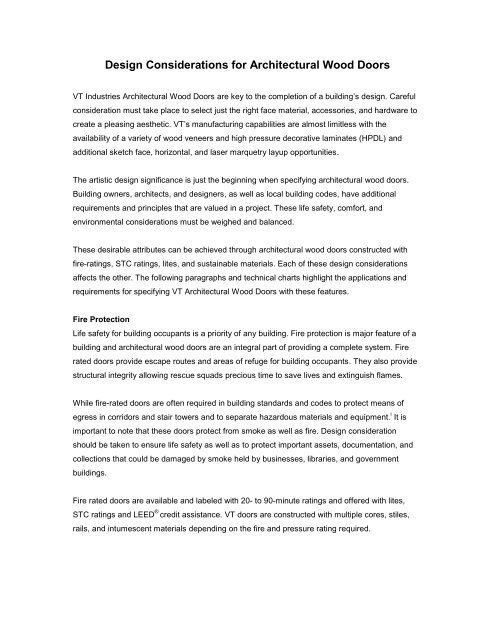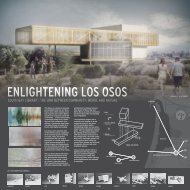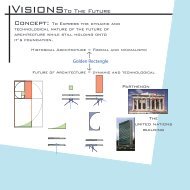Design Considerations for Specifying Architectural Wood Doors
Design Considerations for Specifying Architectural Wood Doors
Design Considerations for Specifying Architectural Wood Doors
You also want an ePaper? Increase the reach of your titles
YUMPU automatically turns print PDFs into web optimized ePapers that Google loves.
<strong>Design</strong> <strong>Considerations</strong> <strong>for</strong> <strong>Architectural</strong> <strong>Wood</strong> <strong>Doors</strong><br />
VT Industries <strong>Architectural</strong> <strong>Wood</strong> <strong>Doors</strong> are key to the completion of a building’s design. Careful<br />
consideration must take place to select just the right face material, accessories, and hardware to<br />
create a pleasing aesthetic. VT’s manufacturing capabilities are almost limitless with the<br />
availability of a variety of wood veneers and high pressure decorative laminates (HPDL) and<br />
additional sketch face, horizontal, and laser marquetry layup opportunities.<br />
The artistic design significance is just the beginning when specifying architectural wood doors.<br />
Building owners, architects, and designers, as well as local building codes, have additional<br />
requirements and principles that are valued in a project. These life safety, com<strong>for</strong>t, and<br />
environmental considerations must be weighed and balanced.<br />
These desirable attributes can be achieved through architectural wood doors constructed with<br />
fire-ratings, STC ratings, lites, and sustainable materials. Each of these design considerations<br />
affects the other. The following paragraphs and technical charts highlight the applications and<br />
requirements <strong>for</strong> specifying VT <strong>Architectural</strong> <strong>Wood</strong> <strong>Doors</strong> with these features.<br />
Fire Protection<br />
Life safety <strong>for</strong> building occupants is a priority of any building. Fire protection is major feature of a<br />
building and architectural wood doors are an integral part of providing a complete system. Fire<br />
rated doors provide escape routes and areas of refuge <strong>for</strong> building occupants. They also provide<br />
structural integrity allowing rescue squads precious time to save lives and extinguish flames.<br />
While fire-rated doors are often required in building standards and codes to protect means of<br />
egress in corridors and stair towers and to separate hazardous materials and equipment. i It is<br />
important to note that these doors protect from smoke as well as fire. <strong>Design</strong> consideration<br />
should be taken to ensure life safety as well as to protect important assets, documentation, and<br />
collections that could be damaged by smoke held by businesses, libraries, and government<br />
buildings.<br />
Fire rated doors are available and labeled with 20- to 90-minute ratings and offered with lites,<br />
STC ratings and LEED ® credit assistance. VT doors are constructed with multiple cores, stiles,<br />
rails, and intumescent materials depending on the fire and pressure rating required.
Acoustical Per<strong>for</strong>mance<br />
The amount of airborne sound blocked from transmitting through a partition is measured in a<br />
Sound Transmission Class (STC) rating. ii STC rated doors are an important product <strong>for</strong> a<br />
building’s acoustical per<strong>for</strong>mance system. Tight fitting doors with STC ratings prevent audible<br />
sound from exiting and limit background noise from passing both in and out of interior spaces.<br />
STC ratings have importance in many applications. Office, school, university and library building<br />
occupants are less distracted creating indoor environments advantageous to productivity and<br />
learning. Law, hospital, and other spaces, where privacy is a necessity, can feel secure when<br />
discussing confidential in<strong>for</strong>mation and subject matter. Additionally, overall communication is<br />
increased with STC rated doors in high per<strong>for</strong>ming acoustical systems.<br />
VT’s STC doors are laboratory tested in operable state to simulate on-site per<strong>for</strong>mance. These<br />
acoustical doors are tested to meet ratings from STC 30 to STC 45. STC 39 and above ratings<br />
require specialized sound retardant core materials. Frame gasket, door bottoms, and accupads<br />
are essential <strong>for</strong> wood doors to achieve STC ratings. These gasket seal system requirements<br />
vary by VT door type, lite sizes, and fire ratings.<br />
Sustainable Materials<br />
VT Industries is incorporating low-emitting and sustainable materials into their products to meet<br />
“green” building requirements, including LEED building standards, and ever-increasing<br />
environmental policies. A 2009 report from McGraw Hill states, “By 2015, MHC estimates 40%-<br />
48% of new nonresidential construction by value will be green. This would equate to a $120<br />
billion - $145 billion opportunity based on MHC’s five year construction market <strong>for</strong>ecast.” iii<br />
LEED building rating systems are by far the most adopted green building programs, especially <strong>for</strong><br />
government projects. According the U.S. Green Building Council’s (USGBC) website, “Various<br />
LEED initiatives including legislation, executive orders, resolutions, ordinances, policies, and<br />
incentives are found in 44 states, including 243 localities (168 cities, 42 counties, and 33 towns),<br />
34 state governments (including the Commonwealth of Puerto Rico), 14 federal agencies or<br />
departments, and numerous public school jurisdictions and institutions of higher education across<br />
the United States.” iv<br />
FSC ® certified, recycled, rapidly renewable, regional, and no added urea-<strong>for</strong>maldehyde doors are<br />
readily available by request <strong>for</strong> door construction with no lost durability and per<strong>for</strong>mance. VT<br />
Industries verifies these claims through third party certifications, GREENGUARD Indoor Air<br />
Quality Certification, ® and the Forest Stewardship Council’s Chain of Custody Certification. These
sustainable attributes and certifications contribute to several LEED credits including MR 4:<br />
Recycled Content, MR 5: Regional Materials, MR 6: Rapidly Renewable Materials, MR 7:<br />
Certified <strong>Wood</strong>, and EQ 4.4: Low-Emitting Materials, Composite <strong>Wood</strong> and Agrifiber Products.<br />
Lites on <strong>Doors</strong><br />
Lites are an additional design element with VT doors. Full, divided, and multiple lite options are<br />
available to create a custom door design. Further customization is available with architectural<br />
glass options that include fire, safety, and specialty finishes, such as stained and textured.<br />
Along with contributing to the building design, lites allow light to be passed into interior spaces.<br />
Natural light can have positive effects on occupants’ moods and mental health, as found in a<br />
report from the Cali<strong>for</strong>nia Energy Commission, “Daylight illumination levels were significant and<br />
positive in predicting better per<strong>for</strong>mance on one test of mental function and attention.” v<br />
Non-rated doors with lites are available with full glass 6” from the stiles and top rail, and 10” from<br />
the bottom rail. <strong>Doors</strong> with multiple lites are available requiring 1-1/2” between lites. Lite size<br />
availabilities are affected by STC and fire-ratings. Careful preparation should be taken be<strong>for</strong>e<br />
specifying lites <strong>for</strong> these doors.<br />
Summary<br />
VT Industries <strong>Architectural</strong> <strong>Wood</strong> <strong>Doors</strong> are manufactured to be aesthetically pleasing and<br />
provide life safety, acoustical, and environmental per<strong>for</strong>mance. The key to a complete<br />
specification is to have knowledge of these doors’ construction and application requirements and<br />
parameters to achieve your design goals. Utilize VT Industries resources, such as product<br />
representatives, product catalogs, and technical data sheets to ensure availability and<br />
correctness when specifying fire-rated, STC, lite, and sustainable doors.<br />
i "Introduction." AHJ’s Guide: Swinging Fire <strong>Doors</strong> with Builders Hardware. Chantilly: Foundation <strong>for</strong> the<br />
Advancement of Life Safety and Security, 2007. 5. Print.<br />
ii "Summary of ANSI S12.60-2002, "Acoustical Per<strong>for</strong>mance Criteria, <strong>Design</strong> Requirements and Guidelines<br />
<strong>for</strong> Schools"." Acoustics.com : Classroom Acoustics : ANSI Standard <strong>for</strong> Educational Facilities. N.p., n.d.<br />
Web. 17 Nov. 2011. .<br />
iii McGraw-Hill Construction. Green Outlook 2011, Trends Driving Growth.<br />
iv "USGBC: Government Resources." USGBC: U.S. Green Building Council. Web. 20 Sept. 2010.<br />
.<br />
v Windows and Offices: A Study of Worker Per<strong>for</strong>mance and the Indoor Environment."<br />
newbuildings.org/sites/default/files/A-9_Windows_Offices_2.6.10.pdf. Cali<strong>for</strong>nia Energy Commission, n.d.<br />
Web. 17 Nov. 2003. .





